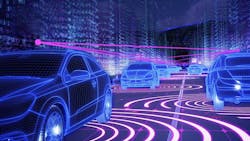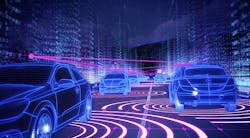Terranet, Mercedes-Benz Demo Ultra-Fast ADAS Sensor
One of the oldest imperatives of advanced driver-assistance systems (ADAS) is speed, shortening the time required to evaluate and adapt sensor input to the complexities of semi-autonomous or autonomous driving. But the speed of change on the road can make it challenging for ADAS circuitry to keep up with what’s going on around the vehicle.
Recently, in a joint presentation with Mercedes-Benz, Terranet AB, developers of driver-assistance software that targets safety issues, showcased its patented 3D VoxelFlow sensor technology at STARTUP AUTOBAHN. Terranet displayed how its VoxelFlow potentially can scan an area with a radius of 40 meters around the vehicle and react in as little as 3 ms.
VoxelFlow uses high-speed sensor technology so that autonomous driving (AD) and ADAS can quickly and accurately understand and decipher what's in front of them, enhancing existing radar, LiDAR, and camera systems that may struggle within 30 to 40 meters. Today, over 94% of all accidents are caused by human error, with a significant amount of those crashes occurring within this range. And this range is where it’s most likely to prevent or not prevent an accident.
At the virtual event, Terranet showcased VoxelFlow technology that scans the area around AV and ADAS vehicles with a response time much faster than today’s ADAS systems, which takes about 300 ms. A breakout session followed where the company engaged directly with attendees interested in learning more about the technology. STARTUP AUTOBAHN is powered by Plug and Play, and sponsored by Daimler and the University of Stuttgart.
VoxelFlow + LiveMap
Through a joint project between Mercedes-Benz and Terranet, VoxelFlow sensor data was fed into a safety map for Mercedes-Benz’s navigation system “LiveMap,” which is updated in real-time. Together, the two technologies can dynamically perceive moving objects and subsequently recognize events and hazard spots. Ultimately, the partnership between Terranet and Daimler aims to drastically improve the overall navigation experience and make roads safer.
VoxelFlow is a solid-state system that will allow AD/ADAS vehicles to perceive the world in what the company characterizes as “3D voxels.” In contrast to 2D pixel-based vision systems, VoxelFlow is said to be currently capable of handling 250,000 voxels per second. By the end of 2021, Terranet expects the sensor technology to process over a million voxels, giving driving automation systems the ability to navigate roadways using 3D data points. In this way, VoxelFlow will enhance existing radar, LiDAR, and camera systems that especially have difficulty operating properly in inclement weather.
VoxelFlow Setup
Three sensor cameras and a continuous laser scanner are mounted on the vehicle. The laser scans the area around the car, in high resolution and at fast speed. The cameras follow the point of the laser beam and detect objects within a 40-meter radius with close-to-zero delay (microseconds), according to Terranet. The vehicle reacts and acts within 3 ms, compared to the 300-ms reactivity of traditional ADAS technology.
If the vehicle is traveling at 70 km/h, it reacts in 6 cm. With traditional ADAS technology, you would travel an additional 5.94 meters. And if you were driving yourself, you would have travelled another 13 meters before being able to react and hit the brakes. What’s more, that might not always be the best solution. Sometimes it’s better to slow down and turn to the side. This is also handled by VoxelFlow.
Where current camera/laser technology is subject to delays in latency or deficiencies in image quality, VoxelFlow creates high-resolution, low-latency images. At 250,000 voxels per second, VoxelFlow is matching competitors in point density. Sensor technology designed specifically with AD/ADAS vehicles in mind, VoxelFlow’s low latency caters to object detection within 30 to 40 meters. Further, the hybrid event-based camera and laser approach enables VoxelFlow to work across all forms of weather and during every time of day.
The system is able to detect, track, and trace a 3D image in addition to specifying velocity, speed, direction, and position. According to Terranet, the system is 50X faster than other existing technology. The company adds that by significantly cutting response time and perceiving the motion of 3D objects in space, VoxelFlow will create a new way of “seeing” for the automotive industry.
Of course, it’s no guarantee that the automotive industry will adopt VoxelFlow technology. There is instead a possibility that a deal will be concluded with a Tier-1 company or semiconductor company as a result of the real-world demo.

